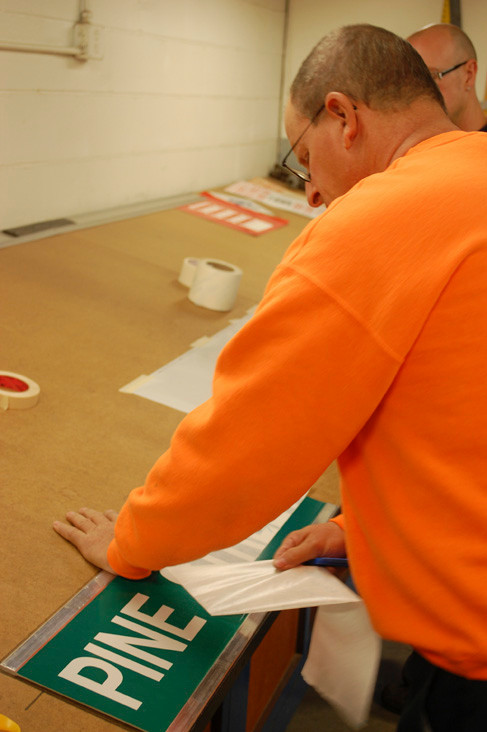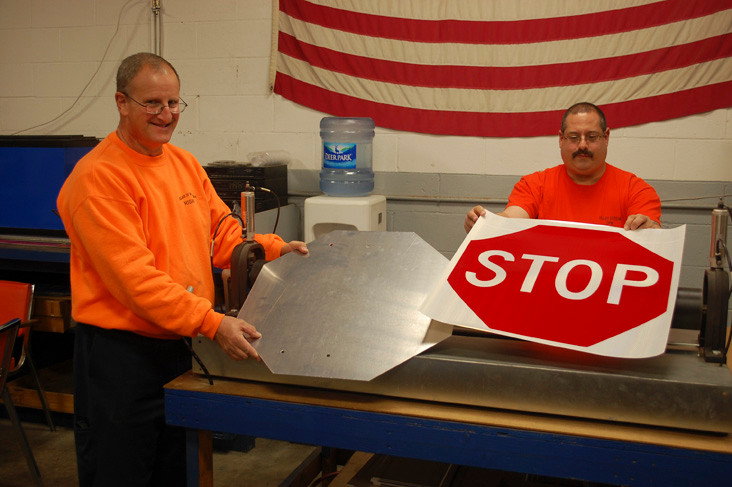Inside the Valley Stream Sign Shop
Ever wonder where all of those signs come from? Stop signs, street signs, no parking signs and even the village’s welcome signs all are made by three men at the Valley Stream Sign Shop, part of the public works facility on Arlington Avenue.
Jim Cassidy, Mike Field and Ed Ochman are responsible for making and installing thousands of signs. When a new parking regulation goes into effect, they make the sign to let drivers know. When a stop sign gets knocked down, they make and put up a new one.
“Everything gets made by hand,” said Cassidy, the Sign Shop’s supervisor.
There are about 1,200 stop signs within the village’s boundaries. The Sign Shop gets the eight-sided metal plates, and the reflective stop sign decal, “like a big sticker,” Cassidy said. The men place the sticker on the plate and put into a machine which uses heat to fuse the two together. Then the stop sign goes up wherever it is needed. Replacing a downed stop sign is always a priority, Cassidy said, adding that those usually get called in to Village Hall or the Highway Department, which then passes along the request to the Sign Shop.
Cassidy said he and his crew are in the process of replacing all the stop signs in the village with ones that are more reflective to be more visible at night. He, Field and Ochman make several at one time, then go out and install the new signs. The process will take a few years to complete, Cassidy said.
A typical parking regulation sign is 12 inches wide by 18 inches high. To make a new sign, first the men stick on the reflective white coating. Then, they go on the computer and print out the vinyl lettering, which gets stuck on by hand.
Street signs are done the same way. The men take a blank metal plate and add on the reflective green background. Cassidy will sit at the computer and type in the name of the street. The letters are 4 inches high, but the width of the letters is determined by the computer, based on how long the street name is. It prints out the letters twice — for each side of the sign.
Whenever a street sign is knocked down or stolen, Cassidy said they are replaced quickly. Some street signs tend to disappear more than others, he said, noting that Cripps Lane, High Street and Marlboro Road are among the most coveted. “Some get stolen more than others,” he said.
The village’s Traffic Advisory Committee often makes recommendations for new regulations, including parking restrictions. When those suggestions are adopted by the Board of Trustees, it is then up to the guys at the Sign Shop to follow through. Cassidy noted that he and his crew will never put up a new sign without the village board’s approval, but can replace existing or missing signs at their own will. Field said that “Autistic Child Area” has been a popular sign request for residential streets in the past few years.
The sign shop has an annual budget of about $250,000 for salaries and materials. It’s also the only department in Valley Stream with its own mascot — the crew takes care of a black cat named Midnight who calls the office home.
While stop signs are pretty easy to make, the most complicated projects are the wooden “Welcome to Valley Stream” signs because of the amount of work and detail involved. “But we like a challenge,” Cassidy said. “They look good and we hope everyone likes them.”
In fact, it was Cassidy who decided to change the welcome signs from green to blue, reserving green signs for the village’s parks.
Cassidy has worked in the sign shop for 15 years. Field came on board in 2003 and Ochman has been there two years. “I’ve always liked working with my hands,” Ochman said. “It’s a nice place to work.”
Ochman, a painting contractor for many years, said he still gets to do some of that, just in a different capacity. In the summer, the Sign Shop crew is also responsible for painting the roads, such as stop lines and double yellow lines, and striping the municipal parking lots.
They are also responsible for the lettering on some village vehicles, such as the Code Enforcement and Auxiliary Police cars.
Cassidy estimates that he and his crew spend about half their time in the shop, and the other half with their work outside. On a rainy day, Cassidy said they catch up on making extra signs. “We try to keep a lot of signs in stock,” he said, “so if something gets knocked down, we can put it up right away.”
There are thousands, if not tens of thousands of examples of their work throughout Valley Stream, but the crew says the number of signs out there is anyone’s best guess. “There’s a lot of signs on 95 miles of road,” Ochman said.

 63.0°,
A Few Clouds
63.0°,
A Few Clouds 











